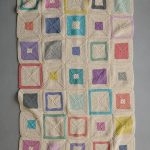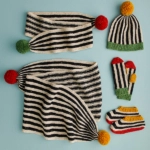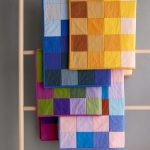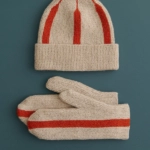Mini Quilt of the Month, March: Masking Tape Quilt

We are so excited about our Mini Quilt project! Each month this year we are bringing you a pattern for a new mini quilt. These small projects are the perfect way to learn a new skill and make something beautiful in the process. To see all of our Mini Quilts, please click here. We are all extra excited about March’s Mini offering, this Masking Tape Quilt which was inspired by some beautiful vintage quilts that we admire. We love how the contrast between the shapes creates play between the foreground and background. For instance, if you focus on the darker shapes the quilt looks like hatch symbols, but if you shift your focus to the lighter shapes the whole thing looks like a series of diamonds that are connected by rectangular pieces. The traditional name of this block is “Churn Dash” but we thought these rectangular pieces looked like little bits of masking tape and so we called it our Mini Masking Tape Quilt.

This is a great project if you’ve just started quilting and want to try your hand at a slightly more complicated block. There is nothing very difficult about it but the sewing needs to be fairly precise in order for all of the pieces to fit together neatly. It’s kind of like a very fun and creative jigsaw puzzle.
Materials

For the fabric we decided to use our Devon Shirtings Bundle which contains 21 beautiful fat quarters from Windham’s Devon Shirting collection. Most of these lovely little prints have an off-white background which makes them perfect for the “masking tape” part of this quilt. From afar these prints are subtle and blend together well but up close there are little stories within each pattern; tiny stars, little dots, thumb tacks and even a mini key. For the darker fabrics we chose a bundle of bright poppy reds, denim inspired blues and grays and used the three dark prints from the Devon Shirting bundle. This particular fabric bundle is no longer available, but please check out all of our current fabrics for some great alternatives.

Dark Fabrics for the Top
- A Masking Tape Quilt Bundle
- 1/4 yard fabric in an assortment of dark prints.
Light Fabrics for the Top
- A Devon Shirtings Bundle. This particular fabric Bundle is no longer available, but please check out all of our current fabrics for some great alternatives. You will need approximately 1 yard of an assortment of prints.
Fabric for the Backing
- 3/4-yard of a Devon Shirting, Black Ivory Thumbtacks. This particular fabric is no longer available, but please check out all of our current fabrics for some great alternatives.
Fabric for the Binding
- 1/2 yard of Robert Kaufman’s Kona Cotton, Coral
You will also need . . .
- Craft size Quilter’d Dream Natural Request Dream cotton batting
- A pencil
Note
All seam allowances in this project are 1/4-inch unless otherwise noted.
Pattern
Cut

You will be making twenty 5 1/2-inch square blocks total. Each one will contain a dark fabric and a light fabric. To start with you might want to cut them and piece them one at a time. Once you get the hang of it you can sew them in an assembly line style. For each block cut the following pieces:
From the dark fabric:
- Two- 2 7/8-inch squares
- Four- 1 1/2-inch squares
From the light fabric:
- Two- 2 7/8-inch squares
- Five- 1 1/2-inch squares
Piece the Blocks

Draw a line with a pencil diagonally across the wrong side of both of the 2 7/8-inch light squares.
Pin these marked light squares to the 2 7/8-inch dark squares, right sides together. Pin them on either side of the markings as shown above.

Sew the squares together 1/4-inch from either side of the markings.
Cut the squares along the marking resulting in two triangles as shown above.

Press these triangles open with the seam allowances pressed towards the dark fabric. Snip off the extra bits at the corners.

This is a clearer picture of pressing the seam allowance towards the dark side of the fabric.

Pin four of the 1 1/2-inch light squares to the 1/2-inch dark squares right sides together along one side.

Sew them together along the pinned side and press the seam allowances towards the dark side.

You will now have nine pieces that will make up the block. Arrange them as shown above. You will be sewing them together to form three vertical strips and then sewing the strips together.

Pin the middle pieces to piece directly below it, right sides together as shown above. Make sure to pin them very carefully and precisely and keep the piece oriented correctly, with the dark sections facing towards the center of the block.

Sew these pieces together and then press the seams towards the dark side.

Pin the top pieces these pieces right sides together.

Sew these pieces together and press the seam towards the dark side. You now have three vertical strips.

Pin the middle strip to the first strip, right sides together. Pin it very carefully and make sure the corners and seams of all of the previously sewn pieces are matching up correctly together. If you need to pull parts of one of the strips a bit to get it to fit properly go ahead.

Sew the middle strip to the first strip and press the seam allowance towards the dark side.

Repeat this to sew on the last strip.
Once you have the completely pieced block you can trim the edges a little to get it as square as possible.
Repeat this until you have 20 blocks.
Piece the Top

Arrange your blocks into a grid four blocks wide by 5 blocks tall. Move them around until you’re happy with the arrangement.

Pin and sew each vertical strip of four blocks together being careful to match up the points of dark shape within each block. Press the seam allowances to one side.

Then pin and sew the horizontal strips together, again being careful to match up the points neatly. After all of the strips are sewn you can trim the edges to get them as straight as possible, without cutting into any of the points.
The top is now done.
Baste
Cut the backing fabric to be 26 by 31-inches. Press it and lay it down wrong side up on a flat surface, like a clean patch of floor.
Cut a piece of batting to be the same size as the backing and lay it on top of the backing.
Press and carefully lay the top, right side up, on the backing and batting layers.
Baste these three layers together using bent arm safety pins. For a more comprehensive explanation of basting please visit our February Mini Quilt of the Month here. Once you get to the story, scroll down near the end to the section called “Baste”.
Quilt
You can quilt this piece in whatever design you like, as long as the quilted areas are no more than 8-inches apart from one another. Below is a demonstration of how we quilted it:

First follow the navy blue line, stitching in the ditch around the diagonal sides of the dark pieces and pivoting around the side angles vertically down the length of the top. Either back stitch or use a very small stitch length at the beginning and end of each quilting seam. Repeat this across all of the blocks.

Next follow the purple lines vertically along the insides of all the dark shapes. You will only be quilting along the insides of the dark shapes, not through them.

When you reach the shapes pick up your foot (but do not cut the thread) and then place the needle into the next light section. You will have unsewn lengths of thread across the dark shapes as shown above. You will cut these later. Make sure to back stitch or use a small stitch length at the beginning and end of each of these small quilting seams.
And finally follow the brown line along the insides of all the dark shapes horizontally in the same manner as the purple line, picking up your foot to pass over the dark shapes.
When you are done with the quilting snip all of the unsewn lengths of thread with a thread clipper.
Bind
Bind the quilt using the Coral Kona Cotton.
If you haven’t bound a quilt before please visit the binding instructions from our January Mini Quilt of the Month: Courthouse Steps here. This quilt (and all quilts!) can be bound in exactly the same manner. Once you get to the story, scroll down near the end to the sections called “Prepare the Binding” and “Bind the Quilt”.






i love the “masking tape quilt”, it also looks like the tape is woven thru. very effective. great tutorial.
this is a beautiful quilt!
may i ask what the dot prints are? i am looking for them on your website and cannot find them. thanks!
Under “Piecing the blocks”, you write to pin the squares together, wrong sides together.
Clearly, it should read “right sides together”, no?
Hi Saggybee-
Thank you so much for pointing this out, it's now been fixed. We really appreciate your careful reading.
Thanks!
Hi Katie-
Thank you for the nice comment. The dot prints can be found here:
https://www.purlsoho.com/purl/products/12-sewing-patchwork-fabric?filters%5B%5D=516&company=187
The shirtings can be found here:
https://www.purlsoho.com/purl/products/item/7951-Windham-Fabrics-Devon-Shirtings
And the bundles to make the whole thing can be found here
:https://www.purlsoho.com/purl/products/item/8118-Purl-Soho-Masking-Tape-Quilt-Bundle
and here:
https://www.purlsoho.com/purl/products/item/8075-Purl-Soho-Collection-Bundle-Devon-Shirtings
Thank you!
This one looks a bit more challenging for me but will have a try !!!
I really enjoy your monthly mini-quilt !!!
This is a lovely tutorial – I am always impressed with your offerings. I have to take exception when you do not credit the authentic name of this block which is CHURN DASH. It's important that new quilters understand the history of our craft and validate it. I don't mind if you 'update' a block – but please do not leave out the most essential part – the true name of the block. Thank you!
Hi Jody,
Thank you so much for letting us know the traditional name of the block. We weren't trying to be flip by calling it something else, we just honestly didn't know what it was called. Thanks for solving the mystery!
Best- Molly
Hi,
I'm wanting to use one of the other solids as my backing — the more orange/heathered red solid that comes in the darks bundle. Can you identify it for me?
Thanks!
Kate
Hi Kate-
The fabric you're referring to is Shot Cotton in Clementine and it's one of our favorites too! Here is a link to it:
https://www.purlsoho.com/purl/products/item/3134-Rowan-Fabrics-Shot-Cotton
Thanks so much!- Molly
Hi,
I love this pattern. Could you tell me the size of block I would need to make a queen size? I don’t know how to figure this. Your help would be appreciated.
Thanks
Sandy
Hi Sandy-
We would recommend just making more blocks to make this a queen sized quilt, not sizing up the blocks.
Thanks for getting in touch!
Molly
I’m a little confused by the illustrations. Are you taking 5″ charm squares and getting 2 half square triangles from each, or are you getting 4 smaller half square triangles? They look like the smaller ones in the picture. What size is the finished block? Maybe I missed that in your description. You mentioned using 21 different shirting fabrics, but then later you said we needed about 1 yard of each kind of cloth (solid and light), so I’m embarrassed to be asking these questions — just hope you’ll be able to clarify for me. I really like the “look” of this little quilt and would like to try to make it. Thanks.
Hi Susan-
The finished blocks are 5 1/2 inches and you will be making 25 blocks total.
For each 5 1/2 inch block you will cut the following pieces:
From the dark fabric:
Two- 2 7/8-inch squares
Four- 1 1/2-inch squares
From the light fabric:
Two- 2 7/8-inch squares
Five- 1 1/2-inch squares
You need 1 yard of fabric in total, so that could be 4 fat quarters, or 8 fat 8ths or a bunch of scraps.
I hope this clarifies things. Please let me know if you have any more questions!
Molly
I think it is fine for a quilter to name a quilt or a block with a name that may be pertinent to her personal project, but I do agree that the traditional name for a block should also be given . Many of the traditional blocks ( including the churn dash block) have more than one name, depending on what part of the country the quilter lived in. I know the churn dash block has a few more traditional names but my memory fails me at this moment, and I cannot tell you them. I should have researched before commenting. Oh well, I will call this a senior moment, which I am having a lot of these days…..
Hi, Carol!
Thank you for writing in! We hear you. We recognize that quilting has a rich history and giving the traditional names for the blocks is important in recognizing that history and the crafters who quilt. We honestly didn’t know what it was called, but once informed we updated it. If you or any other quilters in our crafting community know of other names for the Churn Dash please let us know!
Best,
Kumeko
I have seen a similar minature Churn Dash quilt done in black and blue tones and maybe a mauve or two. It looks like an Amish quilt. This pattern would be a perfect fit for that color scheme. This is a great tutorial! thanks!